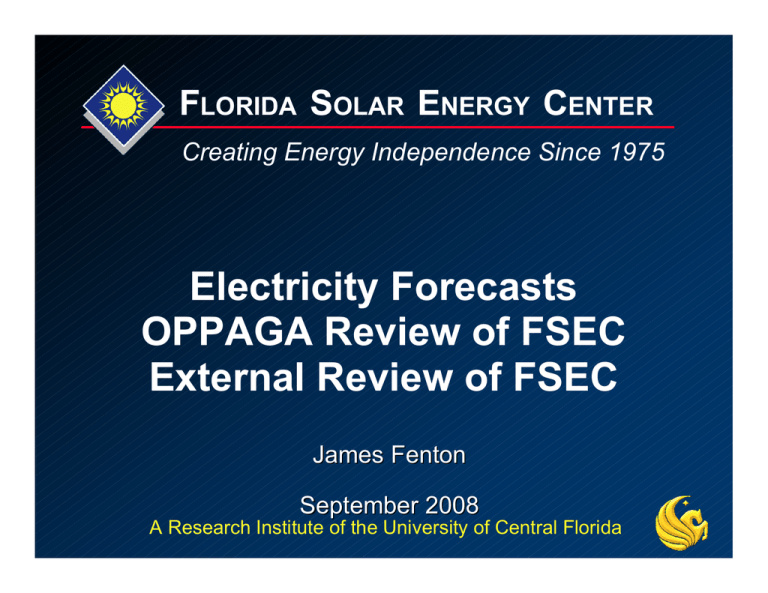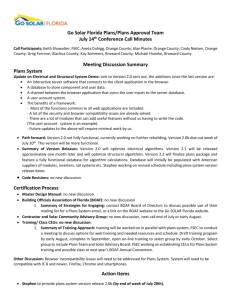Electricity Forecasts OPPAGA Review of FSEC External Review of FSEC F
advertisement

FLORIDA SOLAR ENERGY CENTER Creating Energy Independence Since 1975 Electricity Forecasts OPPAGA Review of FSEC External Review of FSEC James Fenton September 2008 A Research Institute of the University of Central Florida Electric Energy Forecasts Slides taken from Solar Energy Industry Forecast: Perspectives on U.S. Solar Market Trajectory June 24, 2008 United States Department of Energy Solar Energy Technologies Program www.eere.energy.gov/solar/solar_america/ solar@ee.doe.gov 2 3 4 5 6 7 8 What Is This All About? “It’s the economy stupid!” James Carville, 1992 And, the corollary is “… the cheapest, easiest and fastest kilowatt we can generate is the one we save through efficiencies.” Jeb Bush, 2000 In other words: It’s the efficiency stupid! 9 Electricity Use Efficiency, Efficiency, Efficiency….., Then Solar Thermal & PV Efficiency First – The least expensive kWh is the one that we do not use (or produce) New homes (190,000 per year) can cost effectively achieve almost 40% greater efficiency than 2007 code requirements1 Existing homes (7.3 million) can be cost effectively improved by more than 30%1 Achieving this cost-effective efficiency would result in 53 billion kWh savings at a levelized cost of about $0.05 per kWh.1 1 ACEEE, June 2007. Potential for Energy Efficiency and Renewable Energy to Meet Florida’s Growing Energy Demands 10 ACEEE: Energy Savings 350 330 19% Efficiency Savings 290 270 Renewbles - Onsite 6% Renewables - RPS 4% 250 230 2008 Consumption 210 Projected electric sales with EE&RE policies 190 170 EO 127 20% RPS (2% PV; 2% Solar Thermal) by 2020 20 23 20 22 20 21 20 20 20 19 20 18 20 17 20 16 20 15 20 14 20 13 20 12 20 11 20 10 20 09 150 20 08 Electric Sales (Billion kWh) 310 11 ACEEE: Carbon Savings 12 Home Energy Measurement & Verification A national energy use index that measures whole-home energy efficiency on a relative scale ¾ ¾ 100 = The energy use of the “American Standard Home” 0 = No net purchased energy use – the “Zero Energy Home” ENERGY STAR homes have a HERS Index of 85 or lower Widely used in the “Beyond Code” marketplace 13 20% RPS by 2020 (4% Solar) Solar Purchase Requirement: 4% by 2020 6,000,000 2.500% PV as % of Total MWhs 2.000% ST as % of Total MWhs 5,000,000 1.500% ST RECs Purchased 4,000,000 3,000,000 1.000% MWhs Percent PV RECs Purchased 2,000,000 0.500% 1,000,000 0.000% 2008 2009 2010 2011 2012 2013 2014 2015 2016 2017 2018 2019 Year As System costs decline (greater demand, maturing industry), solar requirements increase in later years. Solar Thermal today with no incentives $0.09 kWh; PV with no incentives $0.28 kWh today; $0.15 kWh 2011; $0.09 kWh 2020. Out of the wall $0.08 kWh 2000; $0.12 14 kWh today; $?? kWh 2011. RPS, PBF Industries & Jobs Solar PV Average 13 direct job-years/MW ¾ (VS study of 5 models) Industry estimates that: ¾ Residential: 10 job-yrs/MW ¾ Small Commercial: 9 jobyrs/MW ¾ Large Commercial: 7 jobyrs/MW Solar Thermal One job-year created for every 50 systems installed Benefit of 2% Goal: 32,800 job-years Benefit of 2% Goal: 31,600 job-years (low) 50,000 job-years (high) Orange County Convention Center 1 MW Solar PV 15 How Much Can We Spend? 8.5 million homes Low hanging fruit: ¾ $1500 per home ¾ Saves 1,250 kWh/yr ¾ Saves 25 therms/yr Extensive Retrofit: ¾ $10,000 per home ¾ Saves 5,000 kWh/yr ¾ Saves 100 therms/yr 16 It’s All About the Financing Low hanging fruit ¾ ¾ $13 billion 7.2 year payback Big intervention ¾ ¾ $88 billion 12 year payback 17 Other Benefits Thousands of new jobs Billions of dollars in annual savings to the public Large multiplier impact to Florida economy Improved Homes! Lower operating cost, better durability, safety and IAQ! Genuine national leadership 18 Energy and Economic Development We must: Improve energy efficiency in existing homes (8.5 million) by more than 30% (about two-thirds of all buildings that will be in use in 2050 are already built.) New Homes 45% more efficient by 2018. All with PV and Solar Thermal Government provides $0.75 per kWh/yr saved 2% PV and 2% Solar Thermal RPS 2020; Public Benefit Fund provides 50% cost Fund FSEC to measure and verify energy efficiency, and solar energy production! 19 Action Plan – Step One Make aggressive renewable energy and energy efficiency market development Florida’s 1st energy priority. STATE IS WORKING ON IT 20 Action Plan – Step Two Make advanced photovoltaic research and development a Florida priority. The R&D challenges facing PV technologies are to ¾ Dramatically increase cell efficiency ¾ Reduce the cost/watt ¾ Increase manufacturing capacity. MAJOR TASK OF UCF’S FESC 21 Action Plan – Step Three Significantly enhance Florida’s renewable energy and energy efficiency research, education, job training, certification and demonstration capacity MAJOR TASK OF UCF’S FESC This enhanced capacity would require additional space of approximately 50,000 ft2 at an estimated cost of about $20 million. NEED YOUR HELP 22 FSEC Review (OPPAGA) Requested by Florida Legislative Office of Program Policy Analysis and Government Accountability on July 31, 2008. Provided summary letter (Aug 14, 2008) to the 13 requests Provided 52 Attachments 23 FSEC External Review Team Dr. Richard C. Alkire Emeritus Faculty & Lecturer Department of Chemical & Biomolecular Engineering University of Illinois at Urbana-Champaign r-alkire@illinois.edu Dr. Edward Arens Director Center for Environmental Design Research University of California at Berkeley earens@berkeley.edu Mr. Thomas Boroughs, J.D. Holland & Knight, LLP Tommy.Boroughs@hklaw.com Dr. Chung-hei (Simon) Yeung Global R & D Director, Photovoltaics The Dow Chemical Company Syeung@dow.com 24 External Review Questions 1. How well does FSEC meet its mission and the execution of its strategic plan? 2. How well does FSEC’s goals and programs align with and advance the overall goals of UCF and the state of Florida? 3. How effectively does FSEC meet the needs of its industries? 4. What obstacles hinder the growth and advancement of the center? 5. How well does FSEC meet the needs of its faculty and students? 6. How does FSEC effectively collaborate with other departments and colleges at UCF and at other Universities to take advantage of multidisciplinary and multi-university opportunities? 7. Because FSEC serves a role in the state and metropolitan region, please evaluate the effectiveness of this role and make suggestions for improvement if appropriate. 8. Evaluate and comment on the financial productivity, return on Investment, and viability of the center. 9. Evaluate the research and comment on missed opportunities or 25 suggestions for improvement, if appropriate.



